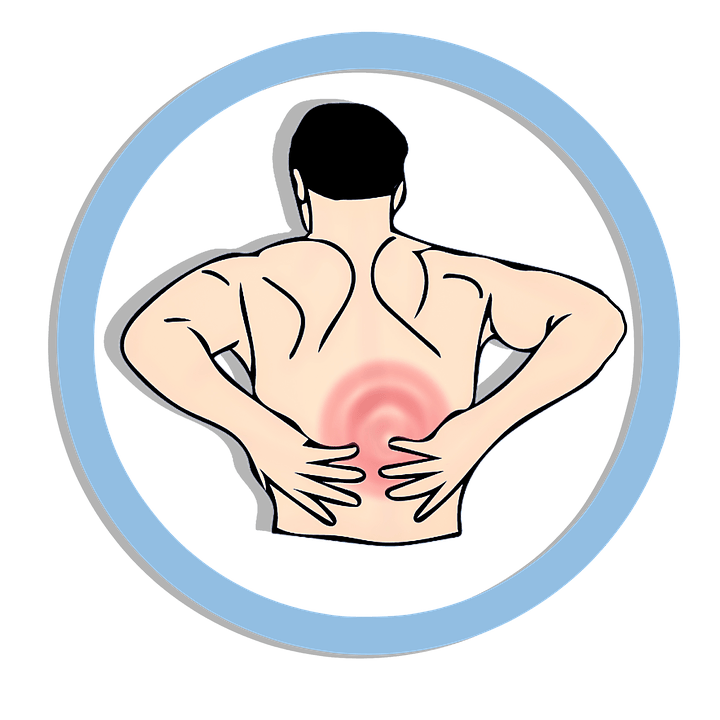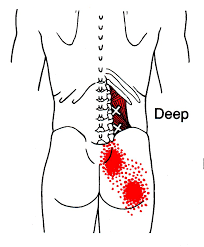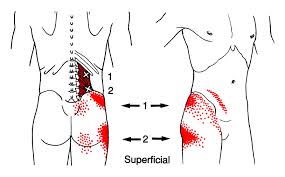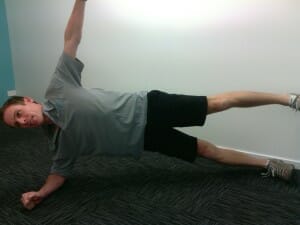The Quadratus Lumborum can cause some real grief through your back, buttock, hip, and groin but with the right management, exercises and self-treatment, you can be pain free – long term.
Where is Quadratus Lumborum Pain Felt?
You can see the pain referral patterns below for the deep (closer to the spine) and superficial fibers of the QL muscle.
Referral from the quadratus lumborum can vary a lot between people due to this varied referral pattern. In some, it can be a literal pain in the butt and others it is the side of the back, hip or the groin.
Quick Anatomy
You can easily see from the video below that as the quadratus lumborum tightens up, it can pull at your bottom ribs, vertebrae or pelvis.
If this happens one side more than the other, it can lead to some real asymmetry and not just cause back pain but a whole raft of other things.

How Can a Tight Quadratus Lumborum Effect You?
Apart from being painful, tight ql can also increase the load on quite a few other structures.
Often when one side tightens up it can lift that side of your pelvis a little making you feel out of place or out of alignment (even though your back can’t go out of place,1).
It can also pull at your ribs, tilting you to the side, limiting your reaching and restricting your breathing.
Last but not least if the QL is tight on both sides, you get more compression on your spine.
The QL can also:
- Cause a sharp stabbing pain in the low back
- Cause pain and limitation when trying to turn in bed or stand from sitting
- Make it look like you have a leg shorter than the other by holding one side of your pelvis higher
- Contribute to a lot of other issues such as patellofemoral pain, trochanteric bursitis and scoliosis due to asymmetrical tension
So How Do We Fix It?
In three steps:
- Decreasing Tension: Ease the pain by decreasing tension by releasing the muscle (stretching often doesn’t help)
- Regain Range of Motion: Get you back to normal by regaining full range of motion through your back and hips
- Strengthening QL: And finally, treat the cause by improving strength of the QL so that it can handle everything you throw at it
1. Decreasing Tension to Ease pain
For this, we need the muscle to relax so the most important thing is reducing aggravating activities and applying heat.
Heat can be applied be a wheat bag, hot water bottle, heat rub or anything similar, it will make a big difference.
Of course make sure you don’t make it too hot or hurt yourself, by following the instructions.
Also, you can directly release the quadratus lumborum, which is far more specific than stretching.
Check out our past blog post to learn how to do a myofascial release for your Quadratus Lumborum with a simple massage ball or the QL Claw.
2. Regain Normal Range of Motion
We need to now get everything back to normal – not just the quadratus lumborum but the muscles that have changed because of the asymmetry that the QL caused.
The following stretch is perfect for this, just remember to relax into it and that it ISN’T, no pain-no gain.
Gluteal Sretch: This will help even you out and regain hip range

3. Strengthen QL
Finally it is important to strengthen your quadratus lumborum stronger so that it can handle what you want to be able to do.
A stronger QL means less pain and you have more control and power, without having to avoid things constantly.
To load the QL, we need to load the side of your body.
The best exercises to do this is the side planks and the one sided farmers carry:
Side plank Level 1
Hold for up to 1 minute. Once you can do that comfortably, progress to level 2 below.
Side plank Level 2:
In the side plank, raise your top leg up and down up to 10 times. Repeat 3 times each side.
 One-sided farmers carry:
One-sided farmers carry:
Hold onto a dumbbell, kettlebell or anything with a bit of weight to it in one hand and do some laps (e.g. 10 x 10m laps on each side).
Carrying a weight on one side makes the QL and obliques on the opposite side work hard to keep you upright.
Note:
Don’t do two-sided carry like in the picture.
Carrying in on the right for example makes the left torso work hard to stop your upper body tilting over and vice versa.
Do one side and then the other.
This can work great to strengthen not only your quadratus lumborum but also your lateral hip and obliques.
Tip: Try to stay upright!
Summary:
And that’s it Folks. Adhere to these efforts and have a pain free and stronger body starting with your QL.
- Heat
- Release
- Stretch
- Strengthen
Work at that most days and notice the results. For a more detailed rehab plan, download our Complete Low Back Self-Rehab Guide to get great results.
On a side note, once you are feeling improved, don’t slack off on the exercises, they are great to do just to maintain yourself in great condition, even if it is just three times per week.







Brilliant! Have been frantically googling my hip/back pain for days without joy. Practical succinct advice – what it is and how to fix it. Just what I needed
I cannot thank you enough for this…..I thought I had done something really serious…info is so straight forward , clear and helpful. Noirin, Scotland 🏴
Thank you for this information. You have described exactly what I am experiencing even down to the mild scoliosis. Will now work hard to gain some improvement.
You are welcome Jeannette! now for the improvement
It’s not clear to me which side you should carry the weight on? Is it the side that’s tight? More explanation, please!
Hi Beth, sorry, good question! Carrying a weight on your opposite side. Carrying something for example in your right arm makes your left lateral torso work to stop your upper body tilting off to the right.
Hi, sorry little confusing. So from your answer to Beth if I’m understanding this correctly, say my right side is tight, I should carry something in my right arm and then the left torso strengthens?? Thank you
Hi Lil, do it on one side and then the other as it is best to strengthen both sides.
Hi, thank you so much for this article, i have been dealing with QL issues for 3 years. My question is how often to do the stretches and exercises?
You’re welcome! It’s great to do the Gluteal stretch 1-2 times daily (number 2) and then the strength exercises every 1-2 days depending on your recovery rate as it’s important to allow recovery and adaptation time when challenging out muscles. Possibly start off every second day to be safe.
I’d also like clarity here.
If the right side QL is the one in pain/tight, does that mean the heavy dumbell should be carried on the right (tight) side, or would that not serve to pull that side down even further ?
Hi Pierre
If the right side Quadrarus Lumborum muscle (QL) is the one you are looking to strengthen, you would hold the weight in your opposite (left) hand. This is because the weight acts to create a pull to one side (the left) that the muscles on the otherwise (the right) have to oppose.
Hopefully that clarifies that and as an extra note, in most cases, it is best to make sure you work both sides – exercise one side and then the other to help balance out.
I’m a retired runner & this QL thing has popped up. I have a golden retriever. The QL thing is on the right side. When I walk her[she’s strong & weighs about 95 lbs…..she’ll pull a lot when walking. Can she be my weight?
My PT suggested that QL muscle may be the cause of my recent very painful lower back and buttock pain and reading your description describes my pain exactly especially the turning over in bed so I will do the suggested advice. Thank you